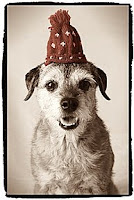
Lhasa Apsos are so cool so have a look at some facts about them!
#1. "Pronunciation: LAH-sa AHP-so."
#2. "The Lhasa A
pso is a small, hardy little dog."
#3. "The body length is longer than the height of the dog."
#4. "The small, dark, deep-set eyes are dark brown and the pendant ears are heavily feathered."
#5. "The front legs are straight."
#6. "The back legs are heavily covered in hair."
#7. "The teeth should meet in a level or slightly undershot bite."
#8. "The feet are round, catlike with an abundance of hair."
#9. "The tail is set high, well feathered and carried over the back in a screw. Some tails have a kink at the end."
#10. "The dense, double coat is straight and long over the entire body, including over the head and eyes, reaching to the floor. Any color is acceptable in the show ring. Gold, cream, and honey are the most popular, but the coat also comes in dark-grizzle, slate, smoke, and multi-colors of brown, white and black. Puppy coats often change colors as the puppy grows. Owners often cut the dogs hair short in a puppy cut to make them easier to care for."
#11. "This is a hardy dog with a friendly, assertive, manner. Intelligent and lively, it makes a good pet."
#12. "Lhasa Apsos are spirited and devoted little dogs, which are affectionate with their masters."
#13. "They can be very obedient to their masters."
#14. "This breed responds to motivational training."
#15. "They have a keen sense of hearing, and make good watch dogs."
#16. "The Lhasa Apso travels well."
#17. "Sadly this little dog often falls into Small Dog Syndrome, a human induced behavior, where the dog thinks he is pack leader to humans. This causes many varying degrees of negative behaviors to come out in the dog. They become suspicious of strangers, and may not tolerate children. They will become willful with a loud persistent bark, as they try and get THEIR humans to listen to them. They will become nervous and untrustworthy with strangers and children, and inclined to fight with other dogs. Often times they will develop separation anxiety, getting very upset when left alone. Followers are not allowed to leave the pack leader, however pack leaders can leave the followers. They can become can snappish if surprised or peeved, and begin to display guarding behaviors. These negative behaviors are NOT traits of the Lhasa Apso, they are human induced behaviors, resulting from the dog not being treated like the canine species it is. Lack of leadership, rules and the lack of limits placed on the dog."
#18. "A mentally stable dog, who gets enough mental and physical exercise will have a totally different personality. It is all up to the humans around the dog. As soon as the humans start being true pack leaders, the dogs behavior will change for the better."
#19. "Height: Dogs 10-11 inches (25-28cm.) ~ a little less for Bitches."
#20. "Weight: Dogs 13-15 pounds (5.9-6.8kg.)"
#21. "Generally a very healthy dog. Sometimes they have skin problems if the coat is not kept free of parasites. They do have a slight tendency to get hip dysplasia. Also kidney problems, eye problems and bleeding ulcers."
#22. "These dogs are good for apartment living. They are very active indoors and will do okay without a yard."
#23. "Lhasa Apso need a daily walk. Play will take care of a lot of their exercise needs, however, as with all breeds, play will not fulfill their primal instinct to walk. Dogs who do not get to go on daily walks are more likely to display behavior problems. They will also enjoy a good romp in a safe open area off lead, such as a large fenced in yard."
#24. "Life Expectancy: About 15 or more years. This breed is very long-lived. Some dogs live up to 18 or more years."
#25. "The long coat parts at the spine and falls straight on either side. No trimming or stripping is needed, although when in full coat, they need to be brushed about once a day to keep their coats from matting. Some owners opt to cut the coats short for easier grooming. Dry shampoo as necessary. Check the feet for matting and for foreign matter stuck there. Clean the eyes and ears meticulously, for they tend to tear. Some owners prefer to get their coats clipped to cut down on grooming. This breed sheds very little."
Info from: http://www.dogbreedinfo.com/lhasaapso.htm
Pic from: http://www.dogbreedinfo.com/lhasaapso.htm

























